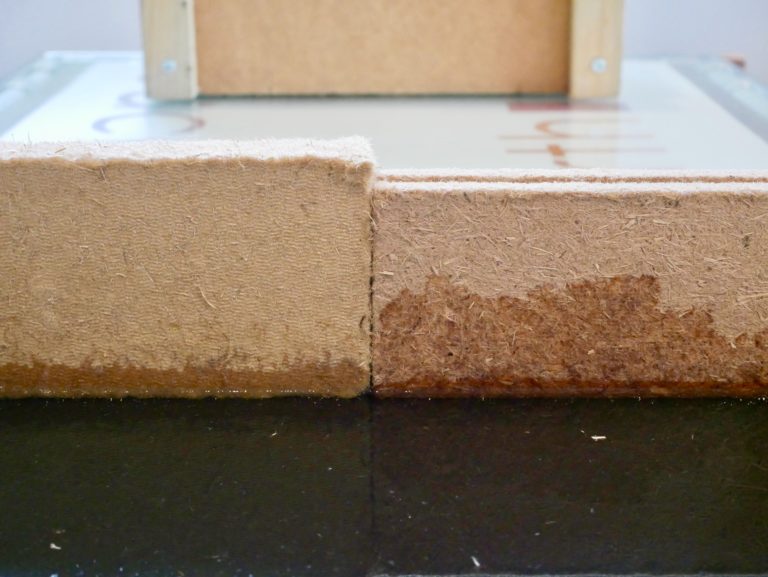SPECIFICATION GENERATOR
Find out which low impact materials are right for your building project.
Wet process vs Dry process wood fibre insulation
Which is the best for you?
Wet-process and dry-process wood fibre boards may look the same on the surface but there are a few differences that we think our customers should be aware of when selecting wood fibre insulation boards. We are only discussing boards here as all types of flexible wood fibre use the same thermally bonded process to create the product.
In the wet-process, you take chipped, waste timber and grind it up into small pieces and then boil it up with water and a few other chemicals designed to break down the timber into the fibres. During this process, many of the sugars which are of interest to fungus and mould are removed. This slurry is then poured on to a belt sieve and compressed to remove as much water as possible and heated with steam to bond the fibres together. The steaming process softens the natural lignin around the fibres which holds the fibres together in the board, which is typically manufactured to around 20mm thickness. These boards are then laminated up with a water based glue into thicker layers to produce boards up to around 120mm thick.
The dry-process also starts with waste timber which is dried and ground up into fibres and then mixed with a synthetic glue. The glue, called PMDI (polymeric methylene diphenyl diisocyanate) is a polyurethane based glue which is used in fairly small quantities (3-4% by mass). This is basically the same glue that is used in OSB and MDF boards and is widely regarded to be very stable and inert and does not ‘off gas’. The mixture is then laid on a conveyor belt and compressed to the correct thickness and density and then steam is applied to cure the boards. These boards are made to the desired thickness and are not usually laminated.
The main differences in functionality between the two types of boards are density (and consequently thermal conductivity and thermal mass) and ability to transport moisture. Wet-processed boards tend to be better at transporting liquid moisture (capillarity), a property which lends itself to managing moisture very well and so these boards tend to be by far the safest for internal wall insulation situations. Wet process boards also tend to have a higher density which is often simply because to get the required compressive strength they need more fibre in the board. This higher density makes them better at preventing overheating and also better for sound absorption, two of the big benefits of wood fibre insulation but does mean their thermal conductivity is higher.
As a demonstration of the difference between the two types of boards, we set up a simple experiment, run over 96 hours, to show how capillary active they are. By sitting samples of the boards in water, it became obvious very quickly that the plain wet-processed boards are able to transport liquid moisture much more effectively than the plain dry-processed boards. By plain we mean no water repellent material is added to the boards to make them suitable for sarking use.

This image shows that after 96 hours sitting in water the wet processed board had transported the water very much further up into the structure that the dry-processed board. By weighing the samples we could also see that beyond 24 hours the water uptake of the dry fibre board had diminished to almost zero whereas the wet fibre board continued to take up water. Please note that this is just to demonstrate the difference and wood fibre boards should not be sat in water as it will damage them.
Dry process boards are often used for roof and timber-framed wall applications as they are tough and can be made in large single thicknesses, usually up to 200mm or so. Because they are less dense than wet process boards they are easier to handle when on a roof, making them safer and preferable. The above experiment also shows that even in saturating conditions, these boards are not going to soak up water which is one of the concerns we regularly come across in our customers. Additionally, the lower conductivity of the boards means lower U-values can be achieved in a given thickness.
The dry process itself also consumes less energy than the wet process does and so the amount of carbon dioxide released by their manufacture is less, making the boards carbon negative overall instead of the roughly carbon neutral wet process boards. This reduction in manufacturing energy also makes them a cheaper board to produce.
So which board is best? As with everything it is never black or white and each type of board will have its merits in different scenarios. However, the one place that we would recommend that you always use a wet-processed board is for internal wall insulation. The extra moisture management ability (and therefore safety) of the wet processed boards is worth the little extra cost. Other than that, the choice is yours.
If you’d like to discuss which type of board will be best for your project, please contact us.